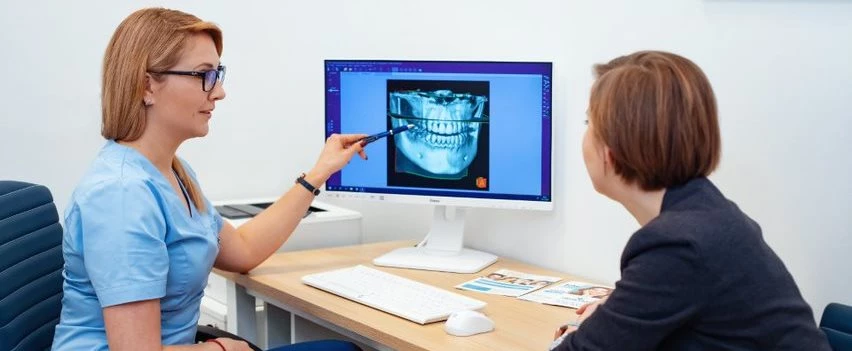1. What is periodontology?
Periodontology is a dental specialty that focuses on the prevention, detection and treatment of periodontal disease.
The tissues that make up the periodontium (forming the periodontal ligament apparatus, i.e. maintaining the tooth) include:
- gum,
- periodontium,
- alveolar bone,
- root cement.
The functions of periodontal tissues include:
- tooth anchoring in the alveolus,
- construction of dental arches,
- providing a barrier against the ingress of microorganisms and the formation of infection,
- feeling the pain, pressure, and touch.
Periodontal diseases include:
- gum inflammation (gingivitis),
- periodontal inflammation (periodontitis),
- periodontological symptoms of systemic diseases as well as developmental and acquired diseases,
- periimplantitis.
Gingivitis is characterised by the inflammation process within the superficial structures of the gum. It is usually caused by excessive accumulation of dental plaque from which bacterial dental calculus is formed. The patient most often complains of bleeding when brushing the teeth. This is the first sign of ongoing inflammation. The examination can show redness and swelling of the gums (especially around the interdental papilla and marginal areas).
Long-term, untreated gingivitis can develop into a more serious condition called periodontitis.
In case of periodontitis, the disease process includes both the gums as well as deeper periodontal tissues. Losing the supporting bone around a tooth results in tooth movement and dislocation, eventually leading to tooth loss. Chronic inflammation often causes bacterial seeding and has an adverse effect on organs located outside the mouth. The most seriously affected organs include:
- heart,
- kidneys,
- joints.
An excessive inflammatory response within the periodontium also occurs in the course of systemic diseases such as diabetes, immunosuppressive diseases, and connective tissue diseases. Moreover, pregnancy does not remain indifferent to the condition of the gums as it makes them softer. In these cases, adequate prevention of periodontal disease is of particular importance.
Periodontal disease can also result from poorly made prosthetic restorations or imperfect conservative treatment.
Cigarette smoking plays an important role in the development of periodontitis – it significantly increases the risk of periodontal disease.
Modern periodontology is increasingly dealing with inflammation of the tissues that surround the implants.
Peri-implantitis and its treatment has become a very important problem of modern periodontology. A healthy periodontium allows the implant to function properly in the mouth. Inflammation of the tissues surrounding the implant, caused by calculus deposits, leads to their damage – and can cause implant loss.
2. Diagnostics
The medical history and properly conducted dental examination allow determining the periodontal condition and therapeutic needs of the patient.
The dentist performs an examination using a special probe (usually a WHO tube), which allows to determine the periodontal condition, shows places with bleeding, assesses furcations (places of root connections in multi-rooted teeth), tooth mobility and the occurrence of recession (gum loss around the tooth).
Oral hygiene assessment plays a key role here. Accumulation of calculus is the main cause of inflammation in the periodontal area.
Radiological tests are also helpful. Pantomographic or cone beam computed tomography (CBCT) has become a standard in diagnosing periodontal disease.
Biological tests are often used to determine the amount of bacteria that cause periodontitis in the examined tissues. The results describe the presence or absence of bacterial DNA.
3. Treatment
There are three steps of the periodontal treatment.
The first step is about the removal of the inflammation cause, i.e. oral pathogens. It includes:
- accurate supragingival and subgingival scaling,
The procedure consists of removing calculus deposits (stone) using special ultrasonic devices, which allow choosing the power and adjusting the shape of the tip for the treatment.
To remove subgingival deposits, curettes are used, i.e. manual tools to clean the root surfaces. In this phase of treatment, specialist devices such as Vector and lasers are often used, which are aimed at thorough cleansing and biostimulation of tissue regeneration.
- extraction of teeth that will fail to survive long-term maintenance,
- elimination of carious cavities and correction of previous fillings and prosthetic works,
- oral hygiene instruction and appropriate patient motivation.
The right technique for cleaning teeth, flossing interdental spaces, as well as the use of special mouthwash liquids is a key factor in maintaining good therapy effects and periodontal disease prevention.
The second step includes corrective procedures. It involves performing surgical procedures aimed at treating periodontal tissues under visual control, changing the appearance of dental tissues, gums, alveolar bone, restoring their normal form and ensuring periodontal regeneration.
It includes:
- gingivectomy or gingivoplasty,
- gingival flap surgery,
- controlled tissue regeneration.
Gingival and mucosal gingival surgery are also often performed, such as gum transplants or recession treatment by shifting the gingival flaps. They are designed to restore the proper condition of the tissues in the area under treatment.
This phase also includes occlusion treatment and restorative therapy aimed at eliminating trauma nodes (premature dental contacts), prosthetic restorations and splints connecting teeth.
The third phase, i.e. maintenance (post-operative) phase, aims to determine risk factors and cooperation with the patient. Long-term maintenance of good treatment results requires proper oral hygiene. At this stage, the dentist concentrates on motivating the patient as well as minimising the impact of risk factors on the course of the disease. Regular follow-up visits are also important. During the check-ups, the dentist has a chance to assess the healing of tissues or quickly detect new pathologies of the oral cavity.
References:
- Wolf H., Rateitschak E., Rateitschak K.: Periodontologia, Lublin, 2006;
- Wierzbicka M.: Periodontologia kliniczna, Warszawa, 1992.

